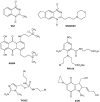ABC transporters in CSCs membranes as a novel target for treating tumor relapse
- PMID: 25071581
- PMCID: PMC4091306
- DOI: 10.3389/fphar.2014.00163
ABC transporters in CSCs membranes as a novel target for treating tumor relapse
Abstract
CSCs are responsible for the high rate of recurrence and chemoresistance of different types of cancer. The current antineoplastic agents able to inhibit bulk replicating cancer cells and radiation treatment are not efficacious toward CSCs since this subpopulation has several intrinsic mechanisms of resistance. Among these mechanisms, the expression of ATP-Binding Cassette (ABC) transporters family and the activation of different signaling pathways (such as Wnt/β-catenin signaling, Hedgehog, Notch, Akt/PKB) are reported. Therefore, considering ABC transporters expression on CSCs membranes, compounds able to modulate MDR could induce cytotoxicity in these cells disclosing an exciting and alternative strategy for targeting CSCs in tumor therapy. The next challenge in the cure of cancer relapse may be a multimodal strategy, an approach where specific CSCs targeting drugs exert simultaneously the ability to circumvent tumor drug resistance (ABC transporters modulation) and cytotoxic activity toward CSCs and the corresponding differentiated tumor cells. The efficacy of suggested multimodal strategy could be probed by using several scaffolds active toward MDR pumps on CSCs isolated by tumor specimens.
Keywords: CSCs; HTS; MDR; P-gp; TICs markers.
Figures
References
Publication types
LinkOut - more resources
Full Text Sources
Other Literature Sources
Miscellaneous






